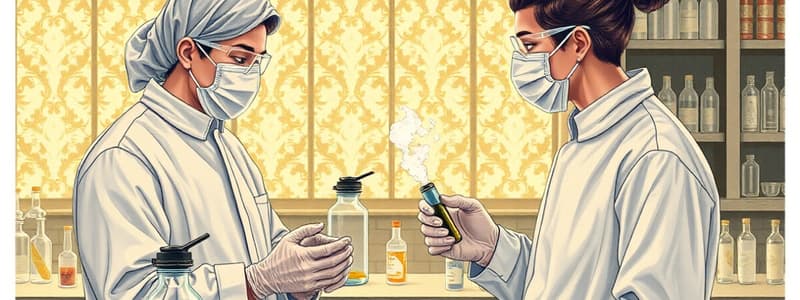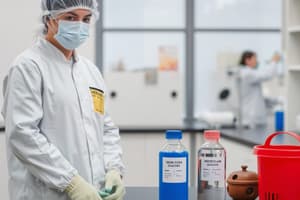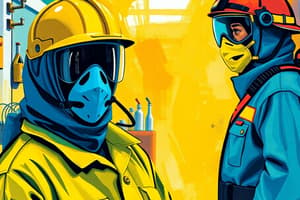Podcast
Questions and Answers
What is the protocol for students who display COVID-19 symptoms before arriving at the lab?
What is the protocol for students who display COVID-19 symptoms before arriving at the lab?
- They must report immediately and seek medical help. (correct)
- They should attend class after notifying their friends.
- They should participate synchronously online without permission.
- They are allowed in the lab if they wear a mask.
Which of the following pieces of personal protective equipment must be worn by students in the lab?
Which of the following pieces of personal protective equipment must be worn by students in the lab?
- Lab coat, goggles, and gloves. (correct)
- Safety boots and a hat.
- Only a mask and gloves.
- Short sleeves for comfort.
What is the maximum number of justified absences a student can have?
What is the maximum number of justified absences a student can have?
- Unlimited justified absences with prior notice.
- One absence for health issues.
- Two justified absences. (correct)
- Three excused absences with valid reasons.
Which statement is true regarding lab experiment repetitions?
Which statement is true regarding lab experiment repetitions?
How should students maintain hygiene during lab work?
How should students maintain hygiene during lab work?
What is an important guideline regarding communication in the lab?
What is an important guideline regarding communication in the lab?
What calculations need to be made before conducting an experiment?
What calculations need to be made before conducting an experiment?
What should students do to prepare for lab exercises?
What should students do to prepare for lab exercises?
What is the primary function of the Pipetman in a laboratory setting?
What is the primary function of the Pipetman in a laboratory setting?
Which Pipetman model would be best suited for transferring 50 μl of a liquid?
Which Pipetman model would be best suited for transferring 50 μl of a liquid?
How can you verify the accuracy of a Pipetman?
How can you verify the accuracy of a Pipetman?
In biochemistry, what term describes the substance dissolved in a solution?
In biochemistry, what term describes the substance dissolved in a solution?
What is the density of water at room temperature relevant for in the context of pipetting?
What is the density of water at room temperature relevant for in the context of pipetting?
What is the concentration expressed as % by mass when dissolving 5 g of NaOH into 100 g of solution?
What is the concentration expressed as % by mass when dissolving 5 g of NaOH into 100 g of solution?
Which statement correctly defines an aqueous solution?
Which statement correctly defines an aqueous solution?
Which of the following equipment is most appropriate for preparing dilutions in a laboratory?
Which of the following equipment is most appropriate for preparing dilutions in a laboratory?
Flashcards
Pipetman
Pipetman
A device used to measure small liquid volumes accurately, ranging from 0.5 µL to 1000 µL. It operates by drawing and dispensing liquid using a piston mechanism.
Solvent
Solvent
The liquid that forms the bulk of a solution, typically water.
Solute
Solute
The substance that dissolves in a solvent to form a solution.
Aqueous Solution
Aqueous Solution
Signup and view all the flashcards
Percent by Mass Concentration
Percent by Mass Concentration
Signup and view all the flashcards
Dilution
Dilution
Signup and view all the flashcards
Stock Solution
Stock Solution
Signup and view all the flashcards
Microliter (µL)
Microliter (µL)
Signup and view all the flashcards
Dilution Formula
Dilution Formula
Signup and view all the flashcards
Laboratory Notebook
Laboratory Notebook
Signup and view all the flashcards
COVID-19 Safety Protocol
COVID-19 Safety Protocol
Signup and view all the flashcards
Concentration
Concentration
Signup and view all the flashcards
Disinfect Working Surfaces
Disinfect Working Surfaces
Signup and view all the flashcards
PPE
PPE
Signup and view all the flashcards
Study Notes
Course Information
- Course: Medical Biochemistry I
- Lab Exercise 1: Introduction to Techniques - Use of Pipetman, Sample Preparation and Dilutions
- Semester: Fall 2024
- Instructors: Andreou M & Kyriakou TC
- Institution: European University Cyprus, School of Medicine
Objectives
- Introduction: Lab characteristics/guidelines
- Part A: Use of Pipetman (theoretical background and exercises)
- Part B: Sample Preparation (main units of concentration and exercises)
- Part C: Dilutions (dilution formula and exercises)
COVID-19 Safety Protocol
- Be on time to avoid crowds at the lab entrance.
- Always bring the required protective gear (lab coat with cuffed sleeves, mask, and goggles).
- Students without the necessary gear will not be permitted in the lab.
- Strict hand hygiene is required (wash hands with soap and put on gloves).
- Disinfect working surfaces before and after experiments.
- Report any symptoms (fever, cough, or breathing difficulties) immediately.
Absences
- Mandatory participation (physical presence or synchronous participation; permission required).
- Only two justified absences are allowed (severe health conditions or emergencies).
- Pre-announce any justified absences before class.
- Lab experiments cannot be repeated.
Preparation for Lab
- Study uploaded materials.
- Print the protocol/experimental methodology.
- Identify required materials and equipment from the protocol.
- Be mentally prepared for technically demanding tasks.
- Wear closed-toe shoes, lab coat, goggles, and gloves.
- Keep hair tied back (ponytail).
- No food or drinks allowed.
Laboratory Notebook
- Record everything explained during the lab.
- Document protocol applications with dates.
- Calculate reagent concentrations (e.g., C1V1=C2V2).
- Evaluate results and identify areas for improvement.
Lab Conduct
- Move cautiously (as if in a bubble).
- Be aware of your surroundings.
- Work as a team.
- Show respect to others.
- Ask questions by raising your hand.
- Avoid fast movements.
- Work quietly.
Contact Information
- Email: [email protected] & [email protected]
- Office: N30 (2nd floor - Medical Building)
- EUC email account policy: Faculty communication through personal email should be notified as it must be sent through EUC email account.
Materials and Equipment
- Pipetman (P1000, P200, P10)
- Pipet tips
- Distilled Water
- 1.0 M CuSO4 solution
- Cuvettes
- Balance machine
- Spectrophotometer
- Weighing boats
- Waste containers
Pipetman Use
-
Pipetman is used for volumes under 1 ml. This is a common tool in labs.
-
Available in three types
- P1000 (200-1000 µl).
- P100 (10-100 µl).
- P10 (0.5-10 µl).
-
Proper use of micropipettes involves recognizing the upper/first/second stops for accurate volumes.
Pipette Accuracy
- The most common method for determining pipette accuracy is weighing water.
- Water density at room temperature is approximately 1 g/ml. Therefore, 1 µl of water should weigh 0.001 grams
Part A: Use of 1000µl and 200µl Pipettman
- Instructions to measure accurately various volumes of distilled water for each Pipetman using the correct procedures.
Part B: Sample Preparation
- A solvent is the liquid that makes up a solution. Water is a common solvent, and solutions formed with water are referred to as aqueous solutions.
- A solute is the material dissolved in the solvent.
- Solution concentration is the amount of solute per unit of solution. Concentration can be expressed as Percentage by Mass (w/w), Percentage by volume (v/v), Percentage weight by volume (w/v), and Molarity (M).
Part B: Calculations and Concentration
- Methods for calculating various concentration units of common solutions (e.g., % by mass, % by volume, % weight / volume and Molarity of common solutions such as NaOH solutions)
Part C: Dilutions
- Most biochemical solutions are prepared by diluting stock solutions.
- The formula C1V1 = C2V2 is used to calculate dilutions, where:
- C1 = Initial concentration
- V1 = Initial volume
- C2 = Final concentration
- V2 = Final volume
- Dilutions may use concentration factors (10X, 20X, etc). Dilution is carried out before use.
Studying That Suits You
Use AI to generate personalized quizzes and flashcards to suit your learning preferences.




